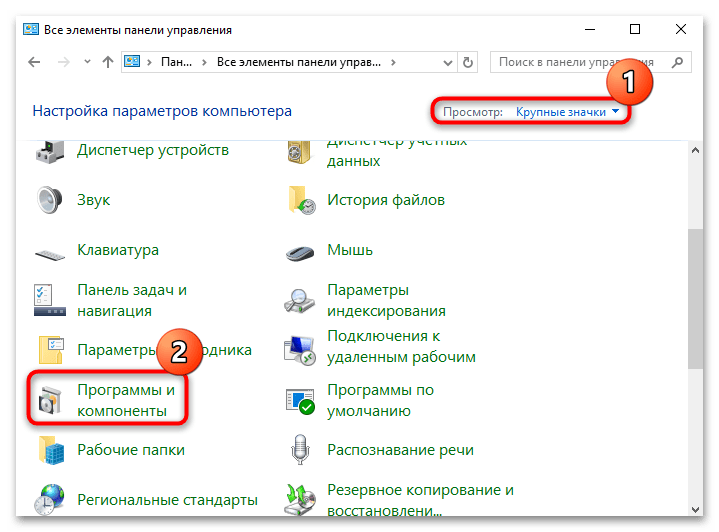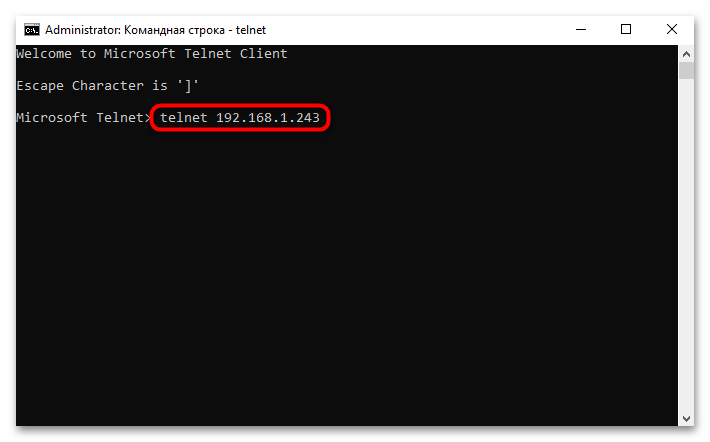Telnet — это один из старейших протоколов для удаленного управления компьютерами и сетевыми устройствами. Несмотря на свою древность, Telnet все еще используется для диагностики, тестирования сетевых сервисов и управления устройствами. В этой статье мы подробно рассмотрим, что такое Telnet, как его установить и настроить в Windows 10 и Windows 11, а также как использовать эту утилиту для диагностики сети и подключения к удаленным устройствам.
Данная информация предназначена для услуг: VPS хостинг
1. Что такое Telnet и для чего он нужен
Telnet (от «Telecommunication Network») — это сетевой протокол для удаленного доступа и управления сервером или устройством через текстовый интерфейс. Telnet использует стандартный порт 23 для установления соединения и может работать как в режиме текстовых команд, так и в виде удаленной сессии.
Основные возможности Telnet:
- Удаленное управление устройствами: Telnet используется для подключения к различным устройствам, включая серверы, маршрутизаторы, коммутаторы и другие сетевые устройства, для выполнения команд или настройки параметров.
- Тестирование подключения: Telnet позволяет проверить доступность определенного порта на сервере. Это полезно для диагностики проблем с соединением и проверкой доступности сервисов.
- Диагностика и мониторинг: С помощью Telnet можно подключаться к различным портам для проверки работы сервисов, таких как HTTP (порт 80), SMTP (порт 25), FTP (порт 21) и других.
Несмотря на то, что Telnet был широко использован в 90-х годах, в современных сетях его часто заменяют более безопасные протоколы, такие как SSH (Secure Shell). Тем не менее, Telnet все еще используется для внутренних задач и тестирования, поскольку его конфигурация проста, а утилита доступна на большинстве операционных систем.
2. Установка Telnet на Windows 10 и Windows 11
2.1. Как включить Telnet в Windows 10
В последних версиях Windows, включая Windows 10, Telnet по умолчанию не установлен, однако его можно легко добавить с помощью нескольких шагов. Для этого:
-
Откройте Панель управления:
- Нажмите Пуск, введите «Панель управления» и выберите соответствующий пункт из результатов поиска.
-
Перейдите в раздел «Программы»:
- В Панели управления выберите Программы, затем Включение или отключение компонентов Windows.
-
Включите Telnet:
- Найдите в списке Telnet Client и поставьте галочку напротив этой опции. Нажмите ОК, чтобы начать установку.
-
Ожидайте завершения установки:
- Windows установит Telnet, и после завершения вы сможете использовать команду telnet через командную строку (CMD).
-
Проверьте установку:
- Откройте Командную строку (CMD) и выполните команду:
telnet
Если Telnet был успешно установлен, вы увидите командную оболочку Telnet.
- Откройте Командную строку (CMD) и выполните команду:
2.2. Как включить Telnet в Windows 11
В Windows 11 процесс установки Telnet почти идентичен Windows 10. Вот как это сделать:
- Нажмите Пуск и выберите Параметры.
- Перейдите в раздел Программы.
- Выберите Дополнительные функции.
- Прокрутите вниз и выберите Добавить функцию.
- Введите «Telnet» в поисковую строку и отметьте Telnet Client, затем нажмите Установить.
После этого вы сможете использовать Telnet в командной строке.
3. Как использовать Telnet в Windows
Теперь, когда Telnet установлен, вы можете использовать его для различных задач, таких как подключение к серверу или проверка доступности порта.
3.1. Проверка доступности порта с помощью Telnet
Одна из самых популярных функций Telnet — это тестирование доступности определенных портов на удаленных серверах. Например, чтобы проверить, доступен ли веб-сервер на порту 80, выполните команду:telnet example.com 80
Где:
- example.com — это доменное имя или IP-адрес сервера.
- 80 — это номер порта (в данном случае HTTP).
Если соединение удастся, вы увидите пустой экран или приветственное сообщение от сервера. Если порт закрыт, вы получите сообщение Connection refused или Unable to connect.
3.2. Подключение к серверу через Telnet
Telnet также позволяет подключаться к серверам и взаимодействовать с ними через командный интерфейс. Например, для подключения к удаленному серверу на порту 23 (по умолчанию Telnet использует этот порт) используйте команду:telnet example.com 23
После подключения вы попадете в консоль сервера, где сможете вводить команды в зависимости от настроек сервера.
3.3. Проверка работы других сервисов через Telnet
Кроме проверки стандартных портов, Telnet можно использовать для тестирования других сервисов. Например, для проверки работы почтового сервера (SMTP) можно подключиться к порту 25:telnet mail.example.com 25
Если сервер доступен, Telnet покажет приветственное сообщение от почтового сервера.
3.4. Использование Telnet для диагностики сетевых проблем
Telnet может помочь при диагностике сетевых проблем. Если вы подозреваете, что определенный сервис не работает, вы можете подключиться к соответствующему порту на сервере и увидеть, есть ли отклик.
Для примера, чтобы проверить, работает ли FTP-сервер, выполните команду:telnet ftp.example.com 21
Если сервер работает, вы получите сообщение приветствия, иначе — сообщение о невозможности подключения.
4. Проблемы при использовании Telnet
4.1. Что такое «Connection Refused» при подключении через Telnet?
Ошибка «Connection Refused» обычно означает, что соединение не может быть установлено. Причины могут быть следующими:
- Указанный порт закрыт или сервис не работает.
- Фаерволл блокирует доступ.
- Указанный сервер недоступен по сети.
- Неверно настроено подключение или сервер не принимает входящие соединения на указанном порту.
Для устранения этой проблемы проверьте конфигурацию фаервола и убедитесь, что нужный сервис работает на сервере.
4.2. «Telnet Connection Refused» при подключении к localhost
Если при подключении к localhost (127.0.0.1) возникает ошибка «Connection Refused», это может означать, что на локальном компьютере не настроен соответствующий сервис. Убедитесь, что нужный сервис работает на локальном хосте и прослушивает правильный порт.
4.3. Telnet и безопасность
Стоит отметить, что Telnet является небезопасным протоколом, поскольку передает данные, включая логины и пароли, в открытом виде. Это делает его уязвимым для атак «man-in-the-middle». Поэтому в современных системах Telnet часто заменяется на SSH, который использует шифрование для безопасного соединения.
5. Альтернативы Telnet
- SSH (Secure Shell) — безопасная альтернатива Telnet, которая шифрует данные и обеспечивает более высокий уровень безопасности при удаленном доступе.
- PuTTY — популярная утилита для Windows, которая поддерживает как Telnet, так и SSH для подключения к удаленным серверам.
- Netcat — инструмент для работы с сетевыми соединениями, используемый для диагностики и тестирования.
Заключение
Telnet — это старый, но полезный инструмент для диагностики сети и удаленного управления серверами. Несмотря на свою уязвимость по сравнению с более современными протоколами, такими как SSH, Telnet все еще остается востребованным для тестирования портов и проверки доступности сервисов. В этой статье мы рассмотрели, как установить и использовать Telnet в Windows 10 и 11, а также как решать типичные проблемы при его использовании.
Помните, что для работы с более важными и конфиденциальными системами рекомендуется использовать более безопасные протоколы, такие как SSH.
Introduction
Telnet serves as a protocol that enables users to remotely access and manage other computer systems over the internet or a local network. It has been around for many decades. Also, it is still employed by some systems administrators and network engineers for troubleshooting & configuring network devices.
Telnet is not enabled by default on Windows OS 10 or 11. However, it can easily be enabled by following a few straightforward steps. Under this tutorial, you will get insights into how to enable and install Telnet Windows 10 or 11. Continue reading and get all the details.
What is Telnet and How Does it Work?

As mentioned in the beginning, Telnet refers to a network protocol that permits users to connect to remote computers and devices over the internet or local network. It is employed for remote administration, troubleshooting, and testing of devices & services.
When you begin a Telnet session, the Telnet client application on your computer system designates a connection to the Telnet to Windows server application on the remote device. This connection is typically established over TCP/IP (Transmission Control Protocol/Internet Protocol), which is the standard protocol employed for communication over the Internet.
Once the connection is established, you can communicate with the remote device utilizing a command-line interface provided by the Telnet client application. You can send Telnet commands as well as receive responses from the remote device.
Further, these Telnet commands in Windows can be utilized to perform a variety of tasks like checking the status of services, configuring network settings, or executing commands on the remote device. Also, you must be aware of the fact that Telnet is not a secure protocol & transmits data, including usernames and passwords, in clear text. As a consequence, it is recommended to employ more secure protocols such as SSH (Secure Shell) for remote administration & access.

The below-mentioned are the three different ways with which you can readily enable or install Telnet on Windows. Let’s quickly get a glance at them!
Install Telnet in Windows using Command Prompt
Step 1: Press the Windows key and type “cmd” in the search box.
Step 2: Then, you need to right-click on “Command Prompt” and select “Run as administrator.”
Step 3: In the Command Prompt window, type
"dism /online /Enable-Feature /FeatureName:TelnetClient" and press Enter.
Step 4: The Telnet client will now get installed on your Windows system.
Install Telnet on Windows Using Control Panel
Step 1: Press the Windows key and type “Control Panel” in the search box.
Step 2: Then, you have to search and click on “Control Panel” from the search results.
Step 3: Next, you must click on “Programs” in the Control Panel window.
Step 4: Click on “Turn Windows features on or off.”
Step 5: In the “Windows Features” window, scroll down and locate “Telnet Client.”
Step 6: Check the box next to “Telnet Client” and click “OK.”
Step 7: Now, by this step, you can enable Telnet on Windows.
Install Telnet with Windows Using Powershell
Step 1: Press the Windows key and type “powershell” in the search box.
Step 2: Then, you have to right-click on “Windows PowerShell” and select “Run as administrator.”
Step 3: In the PowerShell window, type
"Enable-WindowsOptionalFeature -Online -FeatureName TelnetClient" and press Enter.
Step 4: By this step, you will get to enable windows install telnet.
Execute Telnet Command in Windows

To execute the Telnet install command in Windows, you can follow the below-mentioned easy steps:
Step 1: Open the Command Prompt or PowerShell as an administrator.
Step 2: Type “telnet” followed by the IP address or hostname of the remote device you wish to connect to, and then press Enter. For instance, in case you need to connect to a device with IP address 192.168.1.1, you would type “telnet 192.168.1.1” and press Enter.
Step 3: If the connection is successful, you will witness a message that says “Microsoft Telnet>”.
Step 4: You can now type Telnet commands to communicate with the remote device. For instance, if you wish to check the status of a service, you can type “status” followed by the name of the service.
Step 5: To exit the Telnet command in Windows, type “exit” and press Enter.
Check Telnet Client Status on Windows

For checking the Telnet client status on Windows, you can follow these steps:
Step 1: Open the Command Prompt or PowerShell as an administrator.
Step 2: Type “telnet” and then, press Enter.
Step 3: In case the Telnet client is installed and running, you will witness a message that says “Welcome to Microsoft Telnet Client” along with the version number.
Step 4: In case the Telnet client is not installed or running, you will witness a message that says “‘Telnet is not recognized as an internal or external command, operable program, or batch file.”
Step 5: You can also inspect the status of the Telnet client by entering the following command in PowerShell.
"Get-WindowsCapability -Name Telnet.Client*" If the Telnet client is installed as well as enabled, you will see “State : Installed.” If it is not yet installed, you will witness “State : NotPresent.” Moreover, if it is installed but disabled, you will see “State : InstalledPendingReboot.”
Summing Up
Enable Telnet Windows 10 or 11 is a simple and quick procedure. It can be done in just a few steps. While Telnet is not utilized as much as it once was, it can still be an extremely helpful tool for managing network devices as well as troubleshooting connectivity issues.
By following the steps outlined in this tutorial, you can quickly enable or install Telnet for Windows and start employing it to administer your network infrastructure. However, you must note that Telnet is an unencrypted protocol. So, it can potentially disclose sensitive information to eavesdropping. Thus, you must take suitable security standards when utilizing it over a network.
Все способы:
- Что такое Telnet
- Активация протокола
- Способ 1: «Панель управления»
- Способ 2: «Командная строка»
- Применение утилиты
- Вопросы и ответы: 0
Что такое Telnet
Telnet-протокол представляет собой утилиту для подключения с удаленным портам компьютера и установки канала связи. В нынешнее время она довольно редко используется, что обусловлено отсутствием шифрования и проверки подлинности данных, но иногда возникают задачи, которые требуют подключения через протокол Telnet.
Говоря простым языком, программное обеспечение является клиентом с текстовым интерфейсом и позволяет выполнить быстрое подключение одного устройства к другому через интернет. Обычно вся процедура проводится при помощи специальных команд в консоли Windows 10, принцип работы самой утилиты заключается в том, что администратор одного компьютера дает разрешение на подключение к нему другого, а командами Telnet можно получить доступ к программам и различных службам на удаленном компьютере. Так, например, софт используется для разнообразных задач типа получения доступа к файлам, электронной почте, базам данных.
Активация протокола
По умолчанию протокол Telnet в Windows 10 выключен, поэтому перед тем, как им воспользоваться, потребуется его включить. Сделать это можно двумя способами: через соответствующий раздел с программами и компонентами классической «Панели управления» либо через консоль. Оба варианта мы разберем более развернуто ниже.
Способ 1: «Панель управления»
Клиент Telnet – это дополнительный программный компонент операционной системы, поэтому его можно активировать таким же образом, как и некоторые другие аналогичные элементы системы:
- Найдите «Панель управления» в главном меню или воспользуйтесь строкой системного поиска.
- Выберите отображение разделов в виде крупных или мелких значков для удобства, затем нажмите на пункт «Программы и компоненты».
Также сработает и запрос
appwiz.cpl, введенный в диалоговом окне «Выполнить» (одновременное нажатие на «Win + R»), для выполнения которого нужно нажать на «Enter». - На панели слева в открывшемся окне кликните по строке «Включение или отключение компонентов Windows».
- В списке компонентов найдите «Клиент Telnet» и отметьте его галочкой в чекбоксе, а для подтверждения настроек кликните по кнопке «ОК».
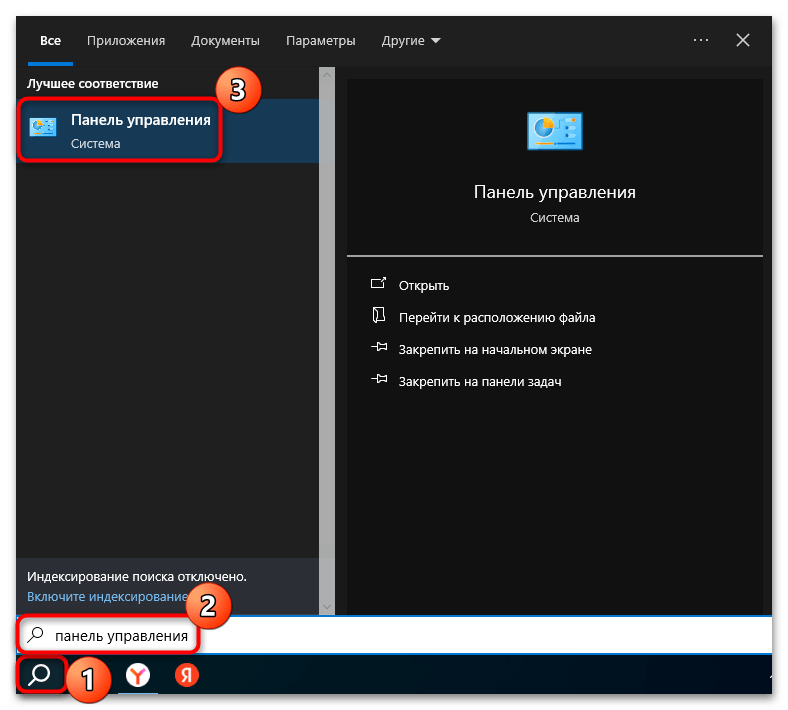

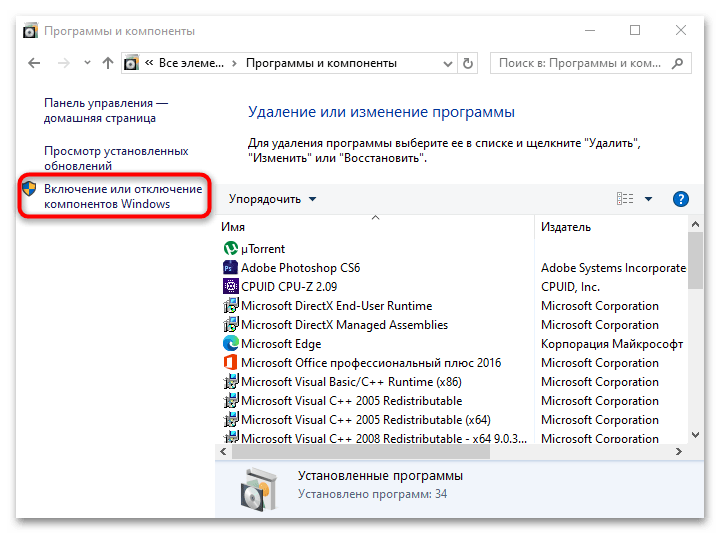

После этого необходимые программные компоненты установятся в систему, и можно будет полноценно пользоваться клиентом.
Способ 2: «Командная строка»
Есть еще один метод активировать программный компонент Telnet, но для этого потребуется знать команду, выполненную с помощью утилиты DISM:
- Запустите консоль «Командная строка» от имени администратора. Для этого также можно прибегнуть к строке поиска, введя запрос
cmdи выбрав соответствующий тип запуска. - Вставьте команду
dism /online /Enable-Feature /FeatureName:TelnetClientв интерфейсе консоли и нажмите на клавишу «Enter» для ее выполнения.
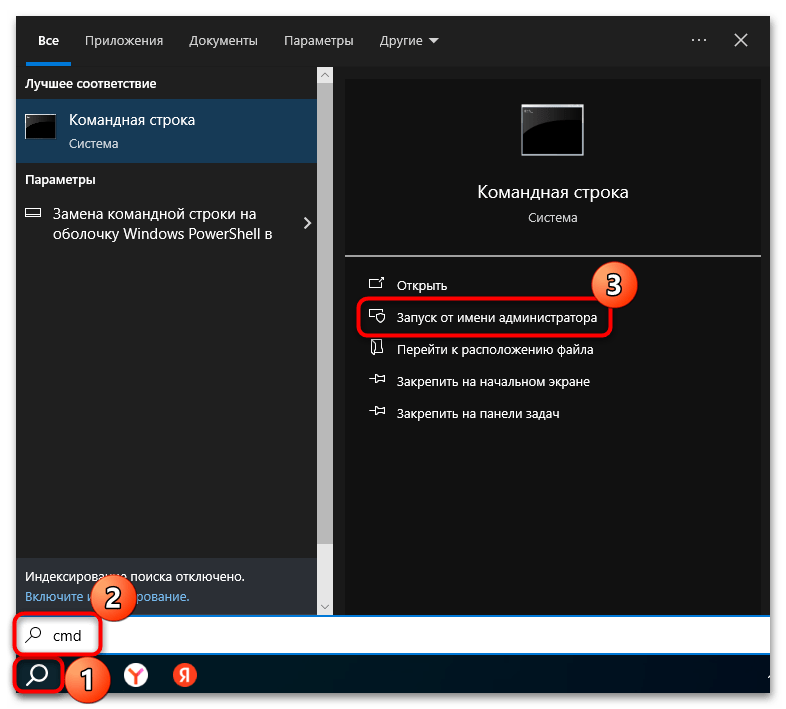
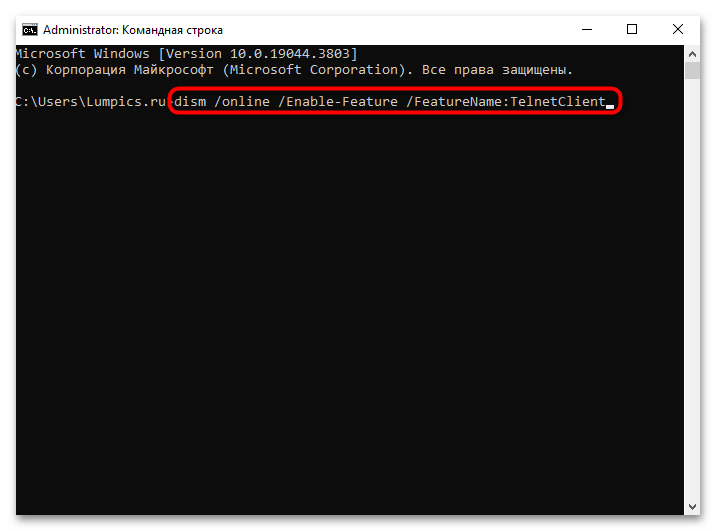
Включить клиент можно и через другую консоль, реализованную в Windows 10, – «Windows PowerShell». Запустить ее потребуется также с расширенными правами, но структура команды, введенной в ее интерфейсе, будет несколько отличаться:
Enable-WindowsOptionalFeature -Online -FeatureName TelnetClient.
На этом активация Telnet завершена – останется дождаться, пока необходимые программные компоненты инсталлируются, после чего можно переходить к его применению.
Применение утилиты
Сетевой протокол запускается исключительно через «Командную строку», поэтому для применения программы потребуется ее открыть, причем от имени администратора. Для начала надо запустить саму утилиту Telnet, затем можно переходить к подключению к серверу и использованию других возможностей:
- В окне «Командной строки» введите запрос
telnetи выполните его, чтобы запустить утилиту. - Далее нужно подключиться к серверам, для этого используйте команду
open serveraddress [port], введя все данные без ошибок. Если все успешно выполнено, отобразится окно, где нужно вписать имя и пароль пользователя. - После можно пользоваться всеми функциями утилиты. Ее синтаксис в рамках «Командной строки» довольно обширный, поэтому разбирать каждый запрос нет смысла. Более подробная информация о командах Telnet представлена на официальном сайте Microsoft на странице технического справочника по ссылке ниже.
Перейти на официальный сайт Microsoft
Мы рассмотрим только несколько простых примеров, чтобы продемонстрировать, как работает протокол Telnet на компьютере с Windows 10. Например, чтобы узнать доступность сервера, потребуется использовать команду
telnet 192.168.1.243, где под цифрами подразумевается IP-адрес или имя хоста.Фактически данная команда является аналогом запроса
ping, но приведенный выше запрос часто используется, чтобы убедиться, что сервер воспринимает команды. - Аналогичным образом можно проверить доступность порта на удаленном сервере. Для этого можно выполнить команду
$ telnet localhost 123или$ telnet localhost 22. - Можно активировать режим отладки для контроля работы утилиты. В этом случае вместе с командой вводится префикс -d:
$ sudo telnet -d localhost 22. - Когда нужно передать команды утилите Telnet, которая располагается именно на удаленном сервере, а не на локальном компьютере, используйте специальный символ ^[ для отображения приглашения ввода Telnet. Чтобы ввести этот символ, нажмите на клавиши «Ctrl + [». Далее для просмотра доступных команд выполните запрос
?, а для того, чтобы узнать статус подключения, есть командаstatusили простоst. В текущей сессии, скорее всего, будут и другие команды, доступные для ввода. - Одно из самых распространенных применений утилиты Telnet – это подключение через консоль к определенному сайту для тестирования и просмотра данных, которые были переданы сервером. Введите
$ telnet site.ru 80, где сочетание «site.ru» замените на адрес нужного ресурса. Как только подключение будет выполнено, используйте/GET, чтобы вернуть заголовки и саму страницу, которые отображаются в браузере. - Чтобы завершить сеанс использования протокола Telnet, выполните
quit.
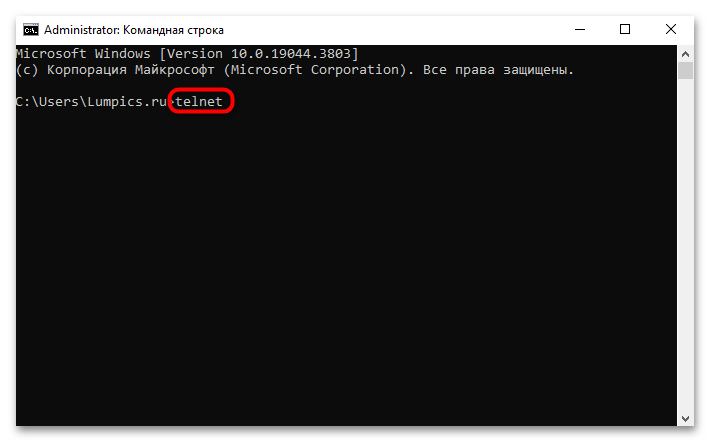
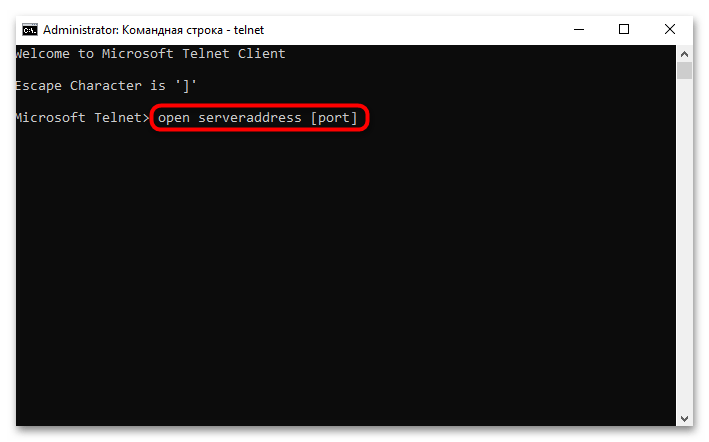
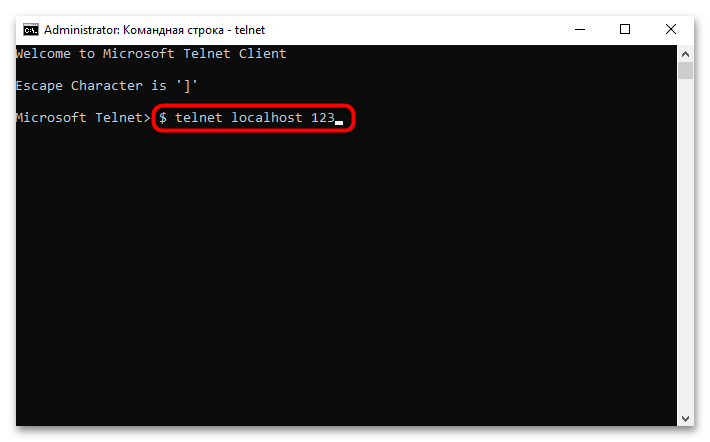
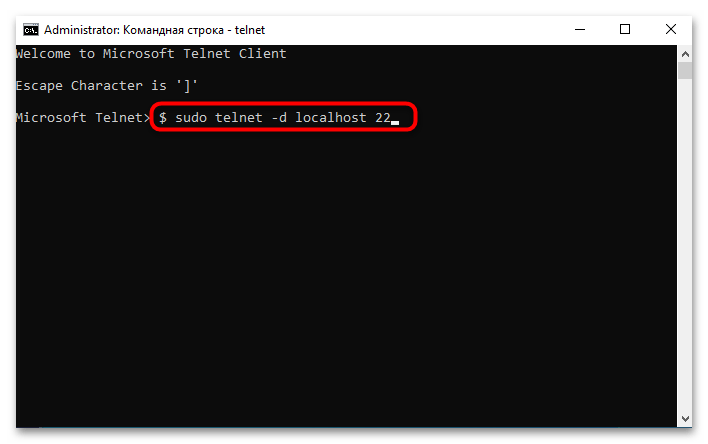
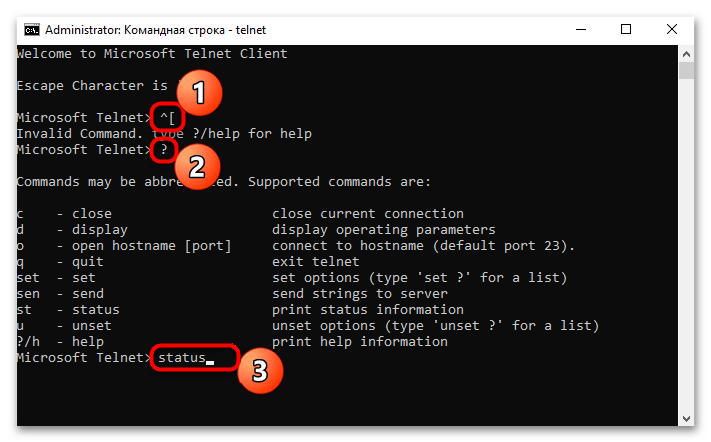

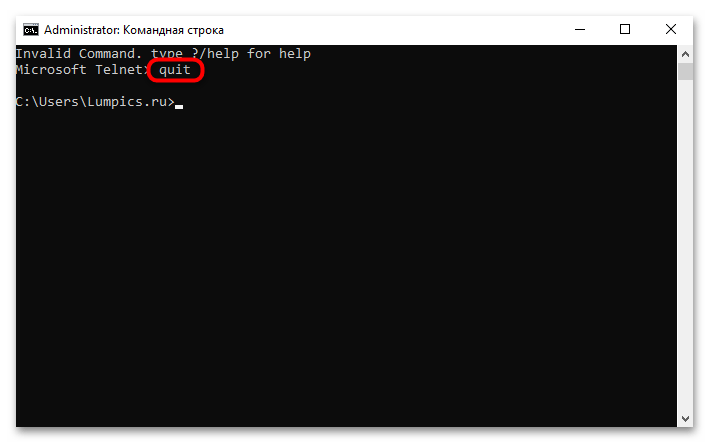
Как видно, спектр возможностей утилиты Telnet довольно обширный, и с помощью нее можно выполнять множество операций с удаленным компьютером, сайтом или сервисом. Но для полного понимания рекомендуем ознакомиться с синтаксисом и особенностями применения, исходя из руководства на сайте Microsoft.
Также следует отметить, что подключение по Telnet не всегда безопасно, поскольку третьи лица или утилиты извне смогут получить доступ ко всем операциям и данным, которыми обмениваются устройства и открывают их друг для друга. Как уже говорилось, это обусловлено отсутствием шифрования и встроенной защиты. Если без утилиты не обойтись, то не забывайте правильно завершать сеанс.
Наша группа в TelegramПолезные советы и помощь
Windows 10 is a feature-rich operating system that’s willing to get as complex as you want it to be. One such instance where only power users are probably experienced revolves around the Telnet client, a substantial constituent of the operating system’s technical functionality. We’re talking about a network protocol here that provides communication with other devices.
Other than that, Telnet’s functionality stretches to other domains as well. This article will cover everything you need to know about this network-based client, including the method you can use to enable it and utilize it efficiently. Be sure to read until the end for favorable results.
What is the Telnet client?
At its very core, Telnet is an internet protocol that establishes communication between a client and a server. It usually employs a TCP (Transmission Control Protocol) or a simple IP (Internet Protocol) connection to allow two ends of a domain to connect under the condition that an identical network is being used. Chiefly, this platform is utilized for remote connections.
As for the working mechanism of Telnet, it’s mainly incorporated with the help of a Command-Line Interface (CLI) similar to the Command Prompt in Windows 10. However, the Telnet client is much more lightweight and speedy and allows a variety of uses to be taken up by power users from all across the globe.
Some of these high-class use cases involve troubleshooting servers, authenticating the number of ports forwarded, gaining remote access to dedicated servers, and optimizing dedicated networks on hardware. There are even more benefits to using the Telnet client in 2022 on a Windows PC, so we see eye to eye with you if this functionality has piqued your interest in recent times.
Now, the thing is, Telnet doesn’t arrive pre-enabled on Windows 10 PCs. This is because it used to be readily available on older iterations of Microsoft Windows, such as Windows XP and Windows 98, which we’re sure only a couple of people in the whole world are still using. Therefore, to use the Telnet client in Windows 10, you will first have to enable it on your operating system.
Thankfully, there is a quick and easy way to do it. By the time you’re finished, you’ll be able to start using Telnet painlessly afterward. The following section will go over just that, so keep reading for more details.
Using Telnet client in Windows 10
Using Telnet client in Windows 10 requires you to enable it first. That is why this section will comprise two distinct sections. One will teach you how to turn it on, while the other will go over its working mechanism. Let’s get started right away.
How to enable the Telnet client in Windows 10
To enable the Telnet client in Windows 10, you must follow the steps given ahead.
1. The first step is to open the Control Panel system app on your Windows PC. This can be done quickly from the Windows Start menu. Type in “Control Panel” and see the application appearing on the screen. Click on it afterward to continue to the next step.

Searching and opening the Control Panel
2. Click on “Programs.”
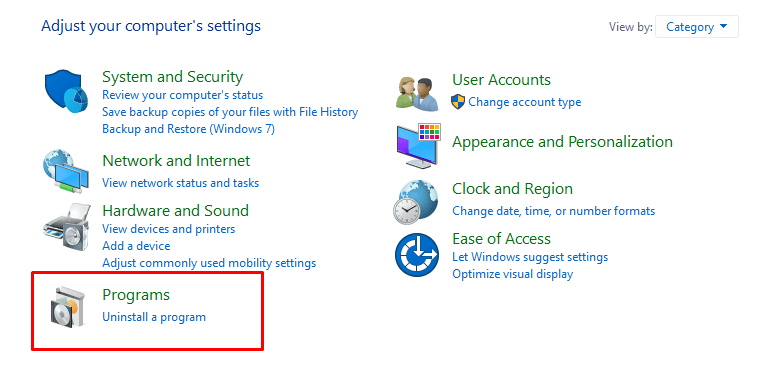
Selecting “Programs”
3. Next, click on “Programs and features.”

Selecting “Programs and Features”
4. Choose “Turn Windows features on or off” to get to the next step.
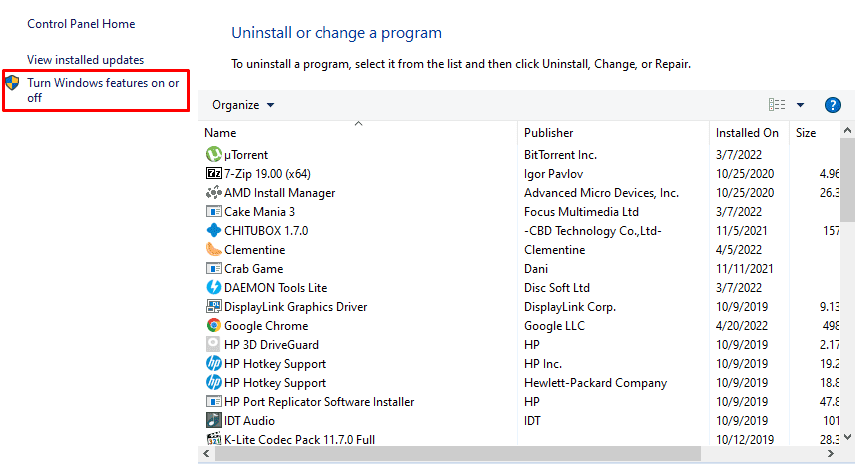
Selecting the relevant option
5. Scroll down the list of options until you see “Telnet client.” Click on the checkbox beside this option once you find it. To finalize, click on the “OK” button.
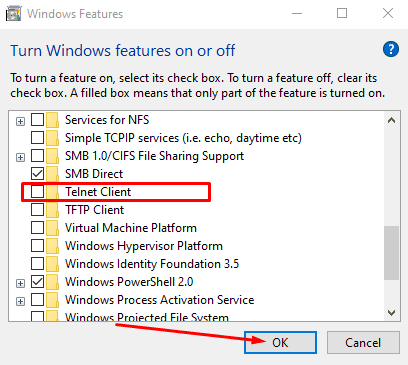
Selecting the “Telnet client” option
6. Click on “Close” after it’s done to finalize the process.
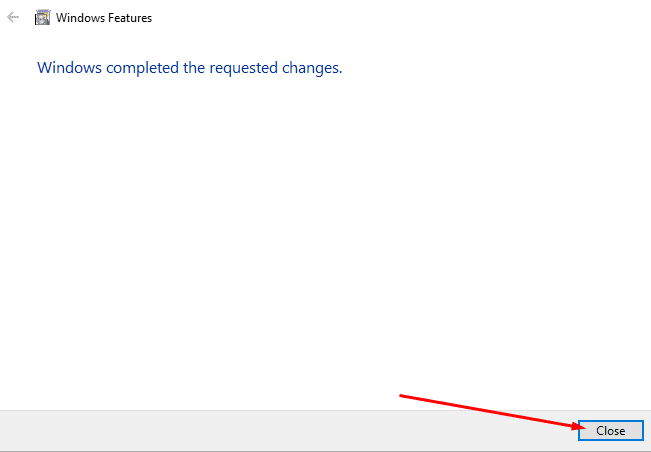
Closing the prompt window
Great going so far! You have successfully enabled the Telnet client in Windows 10, You can now ckly start using Telnet on the operating system.
How to use the Telnet client in Windows 10
The Telnet client in Windows 10 will always be utilized from the Command Prompt, although there are other complex ways to approach it. However, we won’t be getting into any complexity like that in this guide. The Command Prompt will serve as the perfect vessel for running Telnet in Windows 10, so let’s take a brief look at how you can tap into said client and unlock its true potential.
The first step is quite obvious: you have to open the Command Prompt application on your Windows PC. Type “cmd” into the Windows Search bar and click on the relevant application. Ensure that you’re running the software with administrator privileges for the best results.
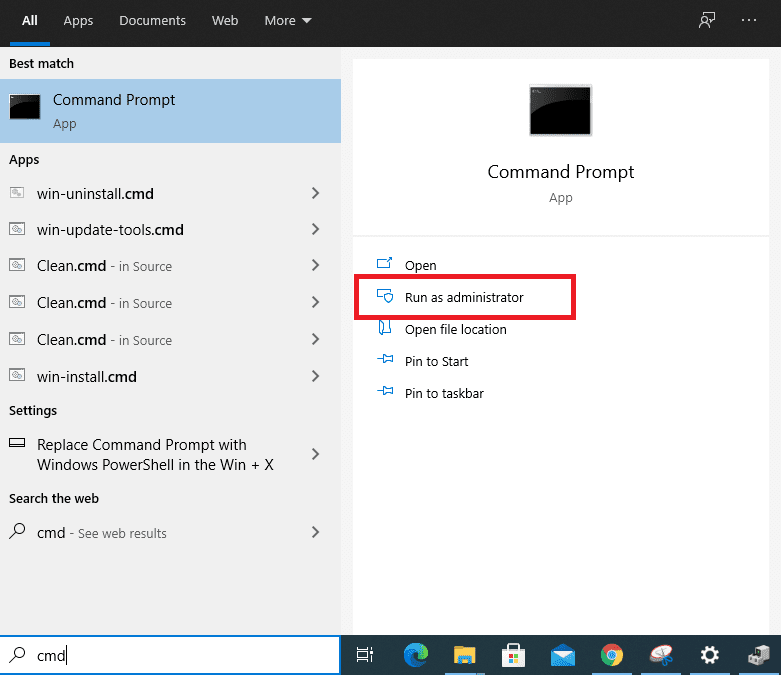
Opening the Command Prompt as an administrator
Type in the following and press the “Enter” key. Doing so will help us activate the Telnet client.
telnet

Tapping into the Telnet client in Windows 10
You’re not entirely done yet. If you want to use the Telnet client in Windows 10 at its full, you have to unlock its features first. For this purpose, you’ll use the following command. Make sure you use the command outside of the Telnet client. Use the “quit” command to exit Telnet and go back to the main command-line interface of the Command Prompt.
dism /online /Enable-Feature /FeatureName:TelnetClient

Unlocking the Telnet client
Now, as for the actual commands that permit effective utilization of Telnet on Microsoft Windows, you’ll have to refer to this handy guide created by the developers themselves. Doing so will help you get to grips with the major Telnet commands around and how to implement them in the Telnet command-line interface (CLI) on your Windows PC.
For example, the “display” command in Telnet returns you the following in the Telnet CLI. This command is effective if you want to know all the different parameters running in real-time when you connect to a Telnet server.

The “display” command in Telnet
Lastly, suppose you want to start connecting to a specific port using Telnet remotely, which is one of the important use cases of this feature. In that case, you can use the “open” command and follow it up by specifying the server’s name that you’re looking to manage. This will take your working experience to the next level.

Using the open command
That’s about it for using the Telnet client in Windows 10.
Conclusion
In this guide, we have discussed an easy way to enable the Telnet client if you’re on Windows 10 and using the feature on your PC. The guidelines were implemented in simple language, so you should be able to get going with this feature right away. Please let us know down in the comments section if this guide proved to help you.
Readers help support Windows Report. We may get a commission if you buy through our links.
Read our disclosure page to find out how can you help Windows Report sustain the editorial team. Read more
If you’re not familiar with it, today we’re going to explain you how Telnet works and can you use it on Windows 10.
The development of Internet saw the invention of many protocols that allowed us to use it better. One of these protocols was Telnet.
What is Telnet and how does it work?
Telnet is an Internet protocol that allows you to connect to a different computer on your local network or on the Internet.
Telnet was invented in 1969, and it’s often considered an ancestor of modern Internet.
Today most users use a graphical user interface, but when Telnet was invented there were no browsers or graphical operating systems. Therefore, users had to rely solely on command line interface.
It’s worth mentioning that Telnet still works like it did decades ago, and Telnet clients are available for almost any platform.
Telnet changed the way how people use Internet because in the time before Telnet users had to manually use the server in order to get certain data.
With Telnet, users could access the server remotely from the comfort of their home for the first time.
In addition to remote access, multiple users were able to connect to the server over Telnet. Therefore, it’s not hard to see how Telnet influenced the development of the Internet.
We have to mention that there are two different terms when it comes to Telnet: Telnet server and Telnet client. The former is a computer designed to run as a Telnet server.
You can easily turn your Windows PC into a Telnet server and you should be able to access it over Telnet.
Bear in mind that having a public IP address leaves your computer open for access by any computer on the Internet, so be sure to use a firewall in order to protect your PC from unauthorized remote access.
The same principles apply to running Telnet on Windows 11, so make sure to check it out if you’re running the latest OS from Microsoft.
- READ ALSO: 7 best tabbed command line tools for Windows 10
Telnet client is a PC that uses a Telnet connection to connect to a Telnet server. In fact, you can use Telnet from Windows 10 by following these steps:
- Press Windows Key + S on your keyboard and enter features. Select Turn Windows Features on or off.
- When Windows Features opens, scroll down and check Telnet Client. Click OK to install Telnet.
- Wait until Windows installs the necessary components.
- Once the installation is completed click the Close button.
After you install Telnet, you can start it by doing the following:
- Press Windows Key + S and enter telnet. Select Telnet from the list of results.
- Command line will now open, and you should be able to use Telnet without any problems.
Why is Telnet obsolete?
Although running Telnet on Windows 10 is fairly simple, the question remains why would you use Telnet for? Telnet is an outdated protocol, and most people don’t use it anymore.
This protocol is great if you are a computer geek, and you want to access Internet by using command line. Unfortunately, there aren’t many Telnet servers available nowadays, so you might have to do some research before you find one.
One of the biggest flaws of Telnet is its lack of security. Telnet transmits all the data between the client and the server without any encryption which means that almost anyone can intercept your data.
This is especially important if you’re sending sensitive information over Telnet, such as your username or password. Due to lack of encryption, malicious users can easily steal your password and see all the data between the Telnet client and server.
Also, Telnet doesn’t have authentication, which means that malicious users can easily intercept your traffic. Lastly, Telnet has several additional security vulnerabilities which make it quite unsafe to use.
Even though Telnet in Windows 10 might not be the safest Internet protocol, newer protocols, such as SSH for example, were inspired by Telnet. They are designed to fix many flaws that original Telnet had.
Telnet might not be as popular as it was a few decades ago. Stll, it’s certain that Telnet changed the way how Internet works forever.
READ ALSO:
- How to protect your Windows 10 device on public Wi-Fi network
- Fix: Network Protocol Missing in Windows 10
- Fix: Error ‘Err_ssl_protocol_error’ in Windows 8.1, 10
- 4 best bandwidth monitors for Windows 10
- How to fix Ethernet problems in Windows 10
Milan Stanojevic
Windows Toubleshooting Expert
Milan has been enthusiastic about technology ever since his childhood days, and this led him to take interest in all PC-related technologies. He’s a PC enthusiast and he spends most of his time learning about computers and technology.
Before joining WindowsReport, he worked as a front-end web developer. Now, he’s one of the Troubleshooting experts in our worldwide team, specializing in Windows errors & software issues.

